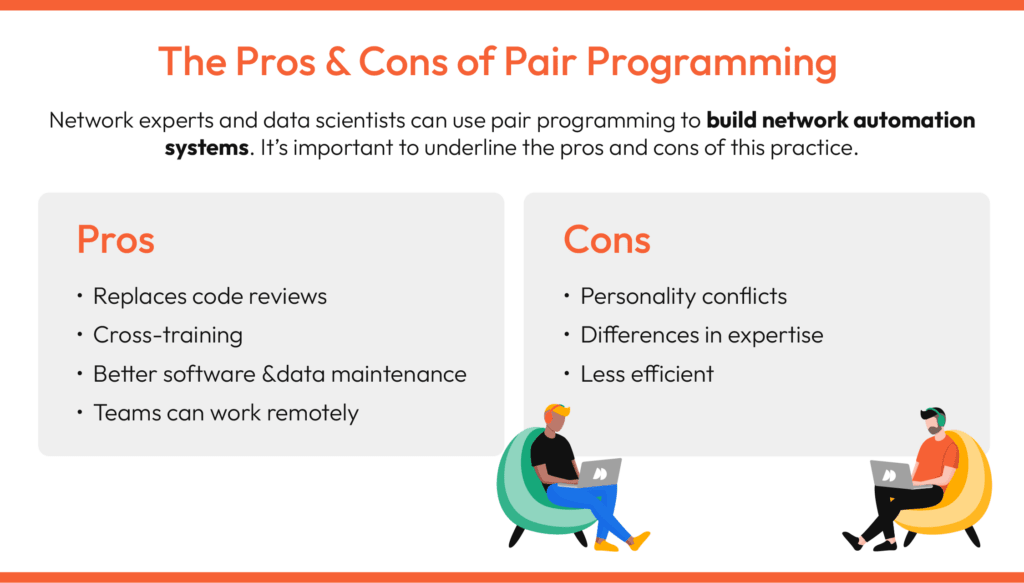Pair programming is a technique in software development where two programmers work together at one workstation. One writes the code (the “driver“), while the other reviews each line of code as it’s written in real-time (the “navigator“).
This dynamic duo approach ensures that the code is not only free from bugs but also adheres to the best design principles. Consider a scenario where we’re trying to build a predictive model using machine learning techniques. The driver might start by cleaning up the dataset – removing outliers or filling missing values – while the navigator observes their approach critically.
Once done with data preprocessing, they might switch roles as they move on to selecting an appropriate algorithm for their model.
By pairing up for complex tasks such as conducting exploratory data analysis, we can leverage combined expertise to ensure accuracy and efficiency. We catch errors on the fly, brainstorm solutions together, and learn from each other’s unique perspectives.
Interested in making better decisions based on better data? Learn more about the data science solutions and services we provide.
Pair Programming: A Definition and Brief History
Pair programming is essentially the tech world’s version of a buddy system. The roles are fluid, with partners swapping hats frequently.
This method first gained traction in the late 1990s as part of Extreme Programming (XP), a software development methodology that emphasized flexibility and customer satisfaction. Over time, pair programming has proven its worth beyond just software development; it’s been adopted in various fields where problem-solving and critical thinking are key.
Traditionally, data scientists have been lone wolves. However, the complexity and sheer volume of today’s data landscape require a shift toward collaborative efforts. This is where pair programming comes into play. Take a look at a few of pair programming’s best practices to better understand its benefits and more about the process involved.
We are not suggesting that individual effort is obsolete — far from it. There’s still immense value in solo exploration, where one can delve deep into intricate algorithms without interruption.
However, having another set of eyes could be invaluable. Your partner might spot that you’ve overlooked a crucial step in pre-processing or suggest an entirely different approach, like convolutional neural networks (CNNs), which are known for their proficiency in image-related tasks.
By embracing pair programming in data science, we combine the best of both worlds — individual expertise and collective intelligence.
Why Data Science Could Benefit From Pair Programming
In data science, we often find ourselves wrestling with massive datasets and complex algorithms. Consider a scenario where we’re working on a machine learning model for predictive analysis. One person could easily get lost in the intricate web of feature selection, hyperparameter tuning, and model validation.
However, with pair programming, while one is deep-diving into the complexities of random forests or neural networks (the driver), the other (the navigator) can maintain a broader perspective. They can monitor overall project goals, check for overfitting or underfitting issues in real-time, and provide immediate feedback.
Pair programming also encourages knowledge sharing. Continuous learning can ignite greater creativity in the process of data discovery, enable streamlined experimentation during model training, and enhance the reproducibility of the codebase. And, the best part? If you get stuck, you can change places. Sometimes the best ideas come to us in our downtime, so the driver may gain a new perspective as a navigator and vice versa.

Steps for Implementing Pair Programming in Your Data Science Team
Now that we’ve seen the potential of pair programming in data science, let’s discuss how we can integrate this practice into our own teams. It’s not about making drastic changes overnight. It’s about gradually adopting a new approach to problem-solving.
- Identify the Skills: It could be statistical modeling, deep learning, or even data visualization. The key is to recognize these individual strengths and use them as building blocks for our pair programming strategy.
- Pair Wisely: Next up is pairing team members wisely. We should aim for complementary skill sets.
- Set Clear Goals: Before starting any project, it’s crucial to set clear goals and expectations.
- Rotate Pairs: We should rotate pairs regularly to encourage fresh perspectives and ideas.
- Embrace Collaboration Tools: Tools like Jupyter Notebook or GitHub can make collaboration easier by allowing real-time sharing and editing of code.
- Encourage Communication: We must foster an environment where team members feel comfortable discussing their ideas and concerns.
- Review Regularly: Regular reviews can help us assess the effectiveness of pair programming and make necessary adjustments.
Overcoming Potential Roadblocks of Pair Programming in Data Science
It’s crucial to acknowledge and address potential roadblocks that might crop up because no methodology is perfect.
One of those roadblocks could be having differing skill levels. On one hand, pair programming promotes knowledge sharing; on the other, it may lead to frustration or slower progress. We recommend establishing a culture of teamwork and continuous learning.
Next up is communication — or rather, miscommunication. Regular check-ins and feedback sessions can help keep everyone on the same page.
Another common issue is resistance to change. Change can be daunting, but highlighting the benefits of pair programming can ease this transition.
Finally, let’s talk about productivity concerns. Some may argue that having two people work on a task that one person could do is inefficient. However, consider this: In data cleaning (which accounts for about 80% of data science work), an extra set of eyes can spot errors or inconsistencies quicker and thus save time in the long run.
The point we are trying to get across is simple: if your team hasn’t tried before, it won’t kill you to. At worst, it’s just another tool in the massive toolbox of development methodologies that could help with certain pain points.

Measuring the Success and Efficiency of Pair Programming
It’s essential to measure the success and efficiency of this approach.
Firstly, we evaluate code quality. By tracking metrics such as error rates or bugs per line of code, we can gauge whether pair programming leads to cleaner, more robust scripts (like a well-optimized algorithm).
Secondly, consider the time taken to complete tasks. While initially, it may seem that pair programming is slower, over time, you might find that complex problems are solved faster and with fewer roadblocks — a testament to collaborative problem-solving.
Lastly, don’t underestimate the power of qualitative feedback. Regular check-ins with your team can provide insights into their experiences with pair programming. Are they learning new skills? Do they feel more confident in their code? These subjective measures can be as telling as any quantitative metric.
Measuring success is about understanding how pair programming impacts your team’s productivity and job satisfaction over time. Like any good superhero story arc, there will be ups and downs, but ultimately, it’s about progress and growth.






